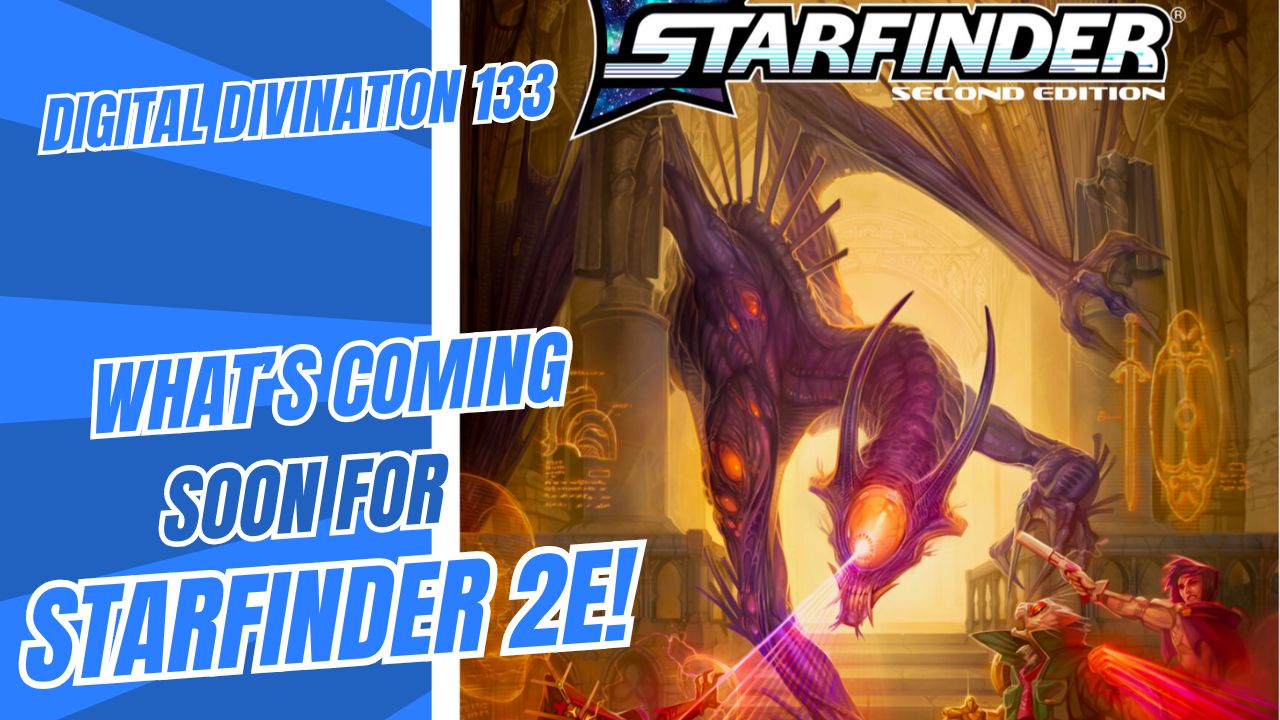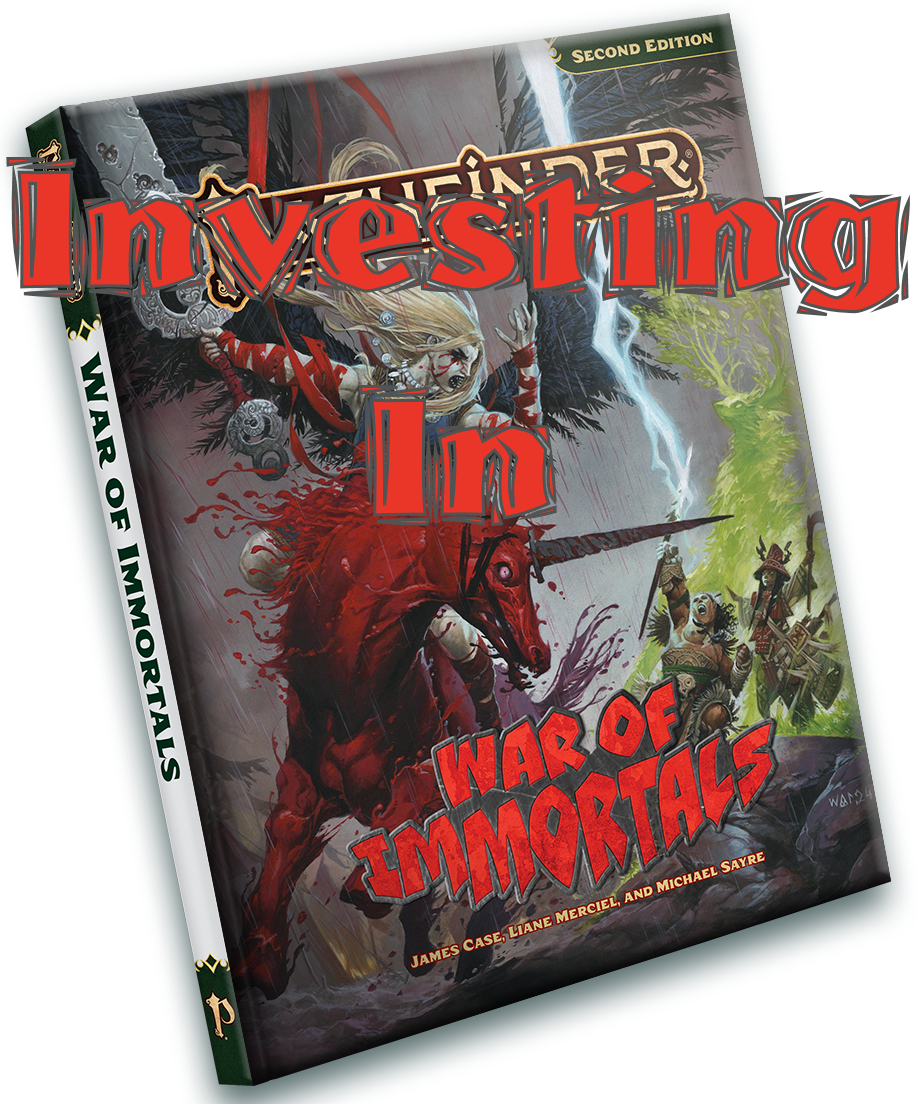The latest addition to the D&D Environments series is Dungeonscape, a sourcebook that explores the dark depths of the game’s most iconic villainous lair. To some it may seem like a stretch that a dungeon is an environment, to others it is the fantasy environment. Can this book, the fifth in the series, live up to everyone’s expectations?
At a Glance
Wizards of the Coast has done a great job of using reoccurring cover styles to tie their books together, and the environment series (Frostburn, Sandstorm, Stormwrack, Cityscape, and now Dungeonscape) has been most spoiled. Each book features great wrap-around fight scene covers. Dungeonscape uses a cold luminous blue and single stream of fire to liven up the chilling cave setting of a battle between a mixed bag adventuring party and a cluster of Beholders with, I presume, the Guardian Template found inside. As a nice switch, we don’t get standard classes doing standard actions. There’s a tiefling rogue on the side of the party, showing WotC’s understanding of evolved habits of its players. There’s also a caster, looks like a Halfling sorcerer, flying and carrying a glowing wand. Fly is a fairly low level arcane spell, and yet it’s so rarely illustrated. And the front-and-center warrior is using flame tongue, a unique magic weapon right out of the DMG.
The art inside has me more excited than I thought possible about artwork in a sourcebook. Page three starts with a meeting between four familiar Player’s Handbook PCs: Jozan the human cleric, Tordek the dwarf fighter, everyone’s favourite halfling rogue Lidda, and Nebin the underutilized gnome illusionist. They’re planning a dungeon delve. Throughout the book, we see them go through the stages of preparation, then entering the dungeon, encountering monsters and traps, and getting picked off one by one. Unfortunately there are occasional continuity problems but overall it’s so cool to see a silent story progress through the book while illustrating its contents.
Highlights
As Clever as it is Useful
Every warrior hates getting ambushed and having to deal with fighting without armour, but is it worth taking the Endurance feat to get over? Not always, but it’s certainly worth the 500 gp it costs to enchant your armour with the Restful ability. Have you ever actually visualize a character carrying a ten foot pole with them? It’s ridiculous. The new collapsible pole, on the other hand, is twelve foot long at full length, but a manageable two feet long when folded up neatly. It’s like the designers sat down, outlined everything that wasn’t as much a challenge for the PCs as it was frustrating for the players and made supplemental rules reflecting their findings. Bonus points for loading up on interesting names like the Cleric-in-a-Box adventuring kit.
On the flipside of the screen, the DM has great tips on Dungeon design and one of the most brilliant new prestige classes, utilitarian beyond logic, the Dungeon Lord. Imagine a villain who lives in a dungeon, knows everything that’s happening in his dungeon, and pretty much sits in this dungeon waiting for infiltrators to wander in and test the limits of his evil. This prestige class is so self-referential they could have called it the Dungeon Master.
Jam Packed
This book is so crammed with options that even the fluff is a little crunchy. Chapter 4: Dungeon Design doesn’t have a single mechanical rule in it, but it features so many helpful hints for outlining an adventure that it may be the first must-read chapter outside the core rulebooks. There is so much in here that I’d like to see used during a session that I can’t decide on a favourite. New alternate class features, which I’m always happy to see, an intriguing new base class, the Factotum, that might be the first hint of how 4th edition base classes will operate, and endless other options that don’t just make for cool ideas, they sounds like so much fun to play.
Dungeons and Beyond
The book may be Dungeonscape, but so much of the content can be applied to any adventure. Advice on plotting an encounter, defined roles for wandering monsters, and advice that really understands how a DM should think. Player options are likewise versatile enough to help outside a dungeon as well as inside. Dungeonscape’s versatility elevates it above most other sourcebooks.
Low Points
Entire Content Should Have Been In DMG II
The DMG II had a lot of very specific encounters and in many cases acts more like a book of examples companion to the DMG than a true sequel. Dungeonscape outlines dungeon crafting so wonderfully, it is the most useful DMing tool released since the DM Screen.
Spread Out Content
Let’s say you want to learn about Walls of Air. They’re described, quite nicely, in a write up on page 20. Armed with knowledge, you now want to know a bit more of the mechanics of using a Wall of Air in your adventure. That information is on page 142, summarized on a chart and in another write up. Why so spread out?
The Factotum, a new base class, is in Chapter 1: The Dungeon As Enemy, even though it is far better suited as a PC class than an NPC. Why isn’t it in Chapter 3: Character Options, alongside the Trapsmith prestige class? What madman was in charge of Dungeonscape’s layout?
Whose Book Is This?
As a DM, I’ve had encounters spoiled by player information. It isn’t the players’ faults, either. They have equal access to sourcebook and the information therein. So if I decide I’d rather take an encounter out of a book than make my own up, I run the risk of my players already having read it. The more clever the encounter, the more likely they are to remember it and the less likely I am to use it.
Dungeonscape has a lot of great ideas that can help a DM craft a unique dungeon. But there’s also some really useful equipment, feats, and prestige classes that players should get the opportunity to sink their teeth into. The more access a player has to a book like this, the less of a surprise it is when the DM unveils a floor of souls or somesuch. Ultimately, if a player buys this book, there’s a lot they can’t use and would be best not seeing. If a DM buys this book, there’s a section specifically for his players that he’ll have to keep for himself or trust his players not to peak outside their designated pages. I’ll freely admit this is not a problem exclusive to Dungeonscape, but it suffers more from it than most other sourcebooks.
Juicy Bits
There is only one base class introduced in this book, the Factotum, a jack-of-all-trades. Earlier I mentioned he might be a preview of what to expect of 4th edition classes. Game Designers David Noonan and Mike Mearls mention in the official D&D podcast that one of the goals of 4th edition is to eliminate the 5 minute work day, where wizards are their most powerful for the first five minutes they’re awake, and drop in power from there. Well the Factotum has powers that replenish every encounter. So he runs out of power halfway through a challenging encounter, but back to full by the next one.
The trapsmith prestige class puts the potency of booby traps into the hands of a player. Nothing too fancy, mind you, but it’s still the first time this aspect of the game is given over to a player.
I can’t say enough about how useful the Dungeon Cast Of Characters sidebar is. Two pages of overlooked fundamentals finally outline for our edification.
Personal Experience
I have a dungeon coming up that puts the dungeon design chapter to use for the first time. I feel strongly that there will be a new level of detail outlined for the coming sessions.
Overall
A sourcebook on designing dungeons, and all adventures indirectly, is ridiculously overdue. It covers basics seven years after 3.5’s debut, and in fun new ways. I love the storyline running through the illustrations, and wish all sourcebooks were as insightful about how the game plays.
I should add that this is my first review after 4th edition was announced. It’s possible that this book was commissioned after it was decided there would be a new edition. I’m speculating, but that might be why so many options strengthen weak points in the rules. Or it might be because Rich Burlew co-wrote it, and he’s been lampooning the game’s idiosyncrasies in his comic strip The Order of the Stick since 3.5 first saw release.
In any case, Wizards of the Coast would be wise to take this entire book, update it, and base the 4th edition DMG around it.
If You Liked This Book…
Then you have fine taste, my friend.
The other four books in the environment series, Frostburn, Sandstorm, Stormwrack, and Cityscape, are all quite different from Dungeonscape in terms of layout and content, but each does embellish upon rules that appear in the DMG. Cityscape is most similar to Dungeonscape, and Stormwrack is probably the most versatile. Unlike the Races of and both Complete series, the environment series gets better with each new release. If Dungeonscape is the last book of the series released, what a stellar finish.
I spit on the Dungeon Master’s Guide II a bit in this review, but it is in fact a handy book for DMs to flip through, if a bit thin of broad rules.
Since he co-wrote it, I’ll also recommend Rich Burlew’s Order of the Stick, a webcomic that could be considered the best D&D-based fantasy comedy ever. www.giantitp.com




Leave a Reply